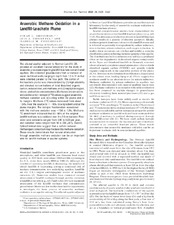| dc.description.abstract | The alluvial aquifer adjacent to Norman Landfill, OK, provides an excellent natural laboratory for the study of anaerobic processes impacting landfill-leachate contaminated aquifers. We collected groundwaters from a transect of seven multilevel wells ranging in depth from 1.3 to 11 m that were oriented parallel to the flow path. The center of the leachate plume was characterized by (1) high alkalinity and elevated concentrations of total dissolved organic carbon, reduced iron, and methane, and (2) negligible oxygen, nitrate, and sulfate concentrations. Methane concentrations and stable carbon isotope (δ13C) values suggest anaerobic methane oxidation was occurring within the plume and at its margins. Methane δ13C values increased from about -54‰ near the source to >-10‰ downgradient and at the plume margins. The isotopic fractionation associated with this methane oxidation was -13.6±1.0‰. Methane 13C enrichment indicated that 80-90% of the original landfill methane was oxidized over the 210-m transect. Firstorder rate constants ranged from 0.06 to 0.23 per year, and oxidation rates ranged from 18 to 230µM/y. Overall, hydrochemical data suggest that a sulfate reducermethanogen consortium may mediate this methane oxidation. These results demonstrate that natural attenuation through anaerobic methane oxidation can be an important sink for landfill methane in aquifer systems. | en |


